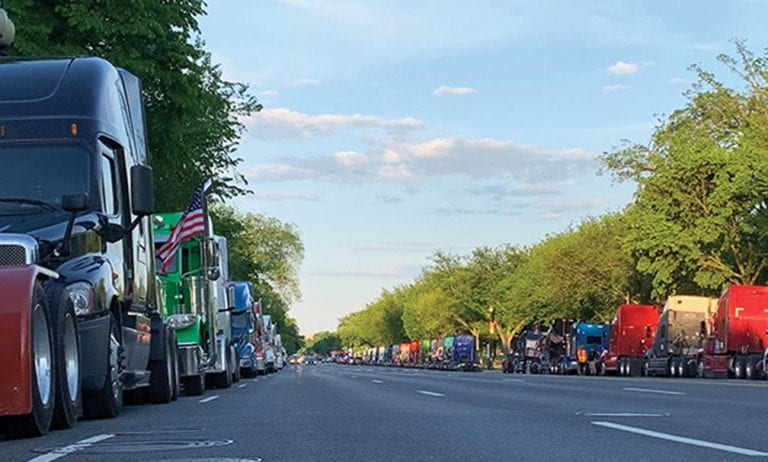It’s been a year since truckers from two Facebook groups — “Mayday 2020” and “The Disrespected Trucker” — plus supporters gathered in Washington to protest low freight rates and demand broker transparency.
Beginning May 1, 2020, protesters parked their trucks along Constitution Avenue in view of both the White House and the Capitol Building, sounding their air horns at intervals to let the population and the press know they were still on site. Protesters demanded a meeting at the White House to discuss ongoing issues.
Broker transparency was frequently mentioned. Complaints centered around the Federal Motor Carrier Safety Administration’s 49 CFR 371.3, a regulation that mandates that brokers share rate information with all parties they deal with in a shipping transaction. Truckers charged that, instead of complying, brokers forced truckers to sign a waiver of their rights to see the information if they wanted to do business.
Those complaints were exacerbated by low spot freight rates. The year 2020 started with rates already suppressed because of overcapacity in the market. A near-record number of new trucks were purchased in 2019, creating a market that was oversupplied with trucks but did not have enough freight to keep them all running.
By the end of March, governments around the world were taking action to combat the COVID-19 pandemic. Manufacturing facilities overseas shut down, curtailing imports to U.S. ports. Then, U.S. manufacturing began shutting down or restricting production as businesses across the country responded to government mandates.
Efforts that began as a 14-day effort to “flatten the curve,” spreading out COVID-19 cases so that medical facilities weren’t overwhelmed, turned into months of closures and slowdowns. In April, the U.S. economy reached its lowest point — and with it, a steep drop in the spot freight rates many small trucking business owners depend on. Truckers charged that brokers were keeping larger percentages of load revenues, a charged refuted by brokers.
For many of the protesters, shutting down their operation to participate in the Washington protest seemed a better alternative than continuing to operate unprofitably.
The Transport Intermediaries Association (TIA), the largest broker organization in the nation, defended broker practices. Then TIA president and CEO Robert Voltmann issued statements claiming broker failure to follow CFR 371.3 was necessary to protect confidential shipper information, and that the practice was longstanding. He highlighted the industry practice of making the information available to carriers at broker offices — but only during business hours — a practice truckers said made reviewing the documentation nearly impossible.
The Owner-Operator Independent Drivers Association (OOIDA) sent letters to members of Congress, urging an investigation of the broker practice. TIA responded with letters to its 1,800 member companies stating that the practice was legal and should be continued.
Mark Meadows, then White House Chief of Staff, addressed the protesters on Day 13 of the protest, telling the crowd, “The president has heard you and he wants us to get something done.” Video of Meadows’ remarks quickly circulated on social media sites as copies were shared and posted on trucker pages.
Meadows also spoke about the Department of Justice’s (DOJ) reversal of a previous decision not to investigate broker collusion and price gouging, announcing that the investigation would now continue. After Meadows’ visit, calls intensified for a White House meeting to discuss the truckers’ demands.
The meeting finally took place May 20 when several representatives, chosen by the protest group, were admitted to the White House for a sit-down with Meadows, then Acting FMCSA Administrator Jim Mullen and Staff Secretary Derek Lyons.
After final remarks and group photos with the Washington Monument as backdrop, the protesters left Washington.
As a result of the protest, the DOJ reversed its refusal to investigate brokers and the White House directed FMCSA’s Mullen to investigate broker compliance with 49 CFR 371.3.
Long-term results, however, have not materialized. Nothing has come of the DOJ investigation into broker collusion, and any FMCSA investigation never got off the ground. Last fall, Mullen left the agency to join autonomous technology developer TuSimple.
The administrative picture in Washington has changed, too, with the election of President Joe Biden, who quickly appointed election rival and former South Bend, Indiana, mayor Pete Buttigieg as Secretary of Transportation. On April 14, Biden nominated current Acting FMCSA Administrator Meera Joshi to assume the role on a permanent basis.
Even the TIA has new leadership with the appointment of Anne Reinke as President and CEO, effective Oct. 26, 2020.
In the year since the initial “May Day” protest, spot freight rates rose to record levels near the end of 2020 and remain strong. As rates rose, concerns over broker transparency have all but faded away. It seems truckers no longer care how much the broker is charging now that rates are high.
This year’s May Day protest, slated for May 1-3 in Indianapolis, Indiana, is intended to address the disruption of jobs due to autonomous trucking, as well as to voice opposition to the PRO Act, which potentially changes the classification of owner-operators, according to protest organizer Will Cook. Broker transparency didn’t even make the agenda.
Cliff Abbott is an experienced commercial vehicle driver and owner-operator who still holds a CDL in his home state of Alabama. In nearly 40 years in trucking, he’s been an instructor and trainer and has managed safety and recruiting operations for several carriers. Having never lost his love of the road, Cliff has written a book and hundreds of songs and has been writing for The Trucker for more than a decade.








